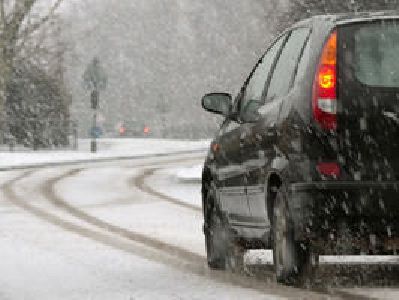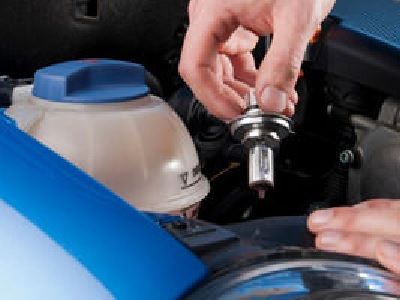Bridgestone Winter Driving School Director and Pro Race Driver Mark Cox lives and drives in the extreme winter conditions of Steamboat Springs, Colorado. Cox has helped Bridgestone Americas Tire Operations pull together the best strategic winter driving tips to take your vehicle on its snow-laden drive this winter and to help you and your family reach your destinations safely.
Before You Drive
Check windshield wiper blades to make sure they work properly.
In some areas, snow blades are an effective alternative to conventional wiper blades.
Have your mechanic test the anti-freeze/coolant.
This will provide the correct level of protection required in your driving area.
Use dedicated snow and ice tires if you live in areas where snow and ice are certainties of winter driving.
Snow and ice tires have a softer tread compound and a unique tread design to provide enhanced traction and road-gripping capabilities. Install snow tires all the way around the vehicle, not just on the drive axle.
Keep your gas tank at least half-full.
The extra volume can help reduce moisture problems within your fuel system. It also adds a margin of safety should you become stopped or stranded during your trip.
Try to remove ice and snow from your shoes before getting in your vehicle.
As snow and ice melt they can create moisture build-up, causing windows to fog on the inside of the vehicle.
Scrape the ice and snow from every window of the vehicle.
And the exterior rear view mirrors, not just a small patch on the windshield. Don’t forget to clean the headlights and brake lights.
Buckle up.
You and your passengers should always use safety belts including lap and shoulder straps. Pull them snugly to ensure they work properly.
Adjust headrests.
Position the driver or passenger’s head rests squarely in the center of the headrest. Rear-end collisions are common in winter driving and a properly adjusted headrest can prevent, or reduce, neck injuries.
Turn off your radio.
Although your radio can provide helpful traffic information, it can also be a distraction for some drivers. Remember, driving is AS MUCH a mental skill as a physical skill.
Stay off your cell phone.
Even if you have a hands-free model, you need to concentrate on driving, not on a telephone conversation, when driving on ice or snow.
Keep your vehicle stocked with simple emergency equipment.
In case you do get stalled or have an accident.
Know the weather where you are, where you’re going and everywhere in between.
If snow or ice is predicted, make plans to leave early or arrive later. An alarm clock set to an earlier time can be a good friend in helping you avoid difficulties.
If you can move a night trip to daylight hours, do so.
Not only is visibility better during daylight, but if your vehicle is stalled, you are more likely to receive prompt assistance during the daytime.
Before you shift into gear, plan the best route to your destination.
Avoid hills, high congestion areas and bridges if possible.
Consider Keeping These Items in Your Vehicle:
When You Drive
Adjust your speed to the current conditions.
When driving in challenging conditions, decreasing your speed will allow more time to respond when a difficult situation arises. Factors such as the type of vehicle you are driving, the quality of tires your car is equipped with, and your abilities as a driver should be considered in the speed adjustment. Remember that posted speed limits identify the maximum speed allowed when weather conditions are ideal. Law enforcement agencies can write citations to motorists driving the posted speed limit if weather conditions warrant a slower speed.
Anticipate difficult situations.
Studies have shown that 80% of all accidents could be prevented with only one more second to react. In many situations, this one second can be gained by looking far enough down the road to identify problems before you become a part of them. Be more alert to the actions of other drivers. Anticipate vehicles coming from side streets and put extra distance between your vehicle and the one in front of you. If someone is too close behind you, don’t speed up; slow down and let them go around you.
Use grip effectively.
When roads are slippery, use all of the grip available. Brake only before the curve when the car is traveling straight. Taking your foot off the brake before you steer into the curve allows you to use all of the grip available for steering. Don’t accelerate until you begin to straighten the steering wheel when exiting the turn. This technique will allow you to be 100% effective at each maneuver. In many situations, better grip or traction can be gained by placing the outside wheels toward the shoulder of the road, out of the ruts in the center. The difference in traction can unbalance the car during the transition from rut to shoulder — so be alert.
Maintain a comfortable driving environment.
A constant flow of cool air will help keep you alert, and keep the windows clear of frost. Keeping one window slightly open will allow you to hear sirens and other warning sounds more quickly. When driving, avoid large bulky boots, gloves and coats, and never drive in ski boots.
Turn on your lights.
When daytime visibility is less than ideal, turning on your lights allows you to see, and to be seen by others. Remember this rule of thumb. Wipers On — Lights On.
When driving at night, leave your head lamps on low beam when driving in snow or fog.
This practice minimizes the reflection and glare, improves visibility, and reduces eye fatigue. When oncoming cars approach, focus on the right side of the roadway to help maintain good night vision.
Keep a smooth, progressive and light touch on the brakes for normal braking.
Even in a car equipped with ABS (Anti-Lock Braking System). In the event of an emergency in an ABS-equipped car, press the pedal HARD and hold it down. Remember that in an ABS-equipped car, you can also steer around many obstacles while braking. Perhaps a better description of ABS would be: “Allows you to Brake and Steer.”
Keep both hands on the wheel.
At 9 o’clock and 3 o’clock positions, and steer smoothly in the direction that you want to go. Avoid the “hand over hand technique.” Instead, utilize the shuffle technique and keep the right hand on the right side of the wheel and the left hand on the left side of the wheel. While this technique may sound overly simple, it can help you avoid skids.
Be careful when using downshifting as a way to slow the vehicle.
Even though manual transmissions may provide greater control to assist with braking, gear changes should always be made smoothly in the straightaway before the corner. Abrupt gear changes, especially while cornering, may upset a vehicle’s balance and cause a skid to occur.
Don’t overestimate the capability of four wheel drive vehicles.
Many drivers mistakenly believe that four wheel drive is all-powerful. Every type of vehicle depends on four small contact patches where the tire meets the road for traction. These small areas are the only contact of your vehicle to the road. Four wheel drive does not improve braking or cornering effectiveness.
Anti-lock brakes can’t perform miracles.
Don’t be misled by ABS braking systems. Braking efficiency is limited by the grip available, and the type of tires with which your car is equipped. If you carry too much speed into a corner and then try to brake, even ABS won’t keep you on the road. Never count on technology to replace good judgment.
Wear quality sunglasses.
Good quality sunglasses help highlight changes in the terrain and road surface even in low visibility conditions.
The world’s best drivers are trained to anticipate problems early.
And direct the vehicle appropriately before they become involved in a problem. Reacting too quickly can be dangerous if the driver’s response is inappropriate.
When driving up a steep hill in icy conditions, gain speed and momentum on the flat before starting uphill.
When the car begins to slow part way up the hill ease up on the accelerator, allow the car to slow down and crest the hill slowly. If you try and accelerate too hard and spin the wheels, you may lose momentum and not make it to the top. It’s better to make the top at a slower speed than to not make it at all.
If you do have trouble, and become stopped or stranded, run the engine only briefly — not continuously — to run the heater.
Regularly make sure that the exhaust pipe is clear of snowdrifts or other obstructions. Carbon monoxide can accumulate more easily in a non-moving vehicle.



